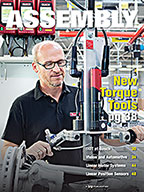Contrary to the desires of Tim Allen in the television show "Home Improvement," bigger is not always better in electric tools. Certainly, a large, powerful motor can apply a lot of torque to a fastener. But, the tool will be useless if its size and weight make it unwieldy.
Fortunately, there is a way to get more torque out of a tool or any electromechanical system without increasing the motor size. The answer is a planetary gearhead. Installed between the output shaft of the motor and the driveshaft of the machine, a planetary gearhead amplifies the torque and improves the dynamic response of an electromechanical system. Planetary gearheads provide high stiffness, low backlash and even load distribution.
A planetary gearhead consists of a sun gear, three to five planet gears, and a ring gear, all coplanar with their axes of rotation parallel. They can be spur or helical gears. The sun and planet gears are external gears; the ring gear is an internal gear. All of the planet gears are in constant mesh with both the sun and ring gears, and rotate on axes fixed to a planet carrier that rotates around the sun gear and within the ring gear.
In operation, the motor shaft is connected to the sun gear, the planet carrier is connected to and drives the output shaft, and the ring gear is held stationary by the gearhead case. The output shaft turns in the same direction as the motor shaft, but at a lower speed. Because it has more gear teeth in mesh, a planetary gearhead provides more torque and greater stiffness than a two-gear, fixed-axis system.
The key performance metric for planetary gearheads is the gear ratio. This ratio indicates the factor by which the gearhead transforms speed, torque and inertia, explains Miriam Bilstein, marketing manager for Alpha Gear Drives Inc. (Bartlett, IL). The motor speed is divided by the ratio, while the torque is multiplied by the ratio. In addition, the gearhead will reduce the inertia reflected to the motor from the load by the square of the ratio. For example, a gearhead with a gear ratio of 10-to-1 will reduce an input speed of 3,000 rpm to 300 rpm, and boost an input torque of 20 newton-meters to 200 newton-meters. And, if the inertia of the load is 10 kg • m2, the motor will only "feel" 0.1 kg • m2.
The gear ratio is the pitch diameter of the ring gear divided by the pitch diameter of the sun gear, plus 1. Thus, if the ring gear pitch diameter is 60 millimeters and the sun gear pitch diameter is 20 millimeters, the gear ratio is 4-to-1. For practical purposes, the lowest possible gear ratio is 3-to-1, while the highest is 10-to-1. Gearheads can be combined to obtain gear ratios greater than 10-to-1, but a gear ratio of 2-to-1 or less is impossible. A gear ratio of 5-to-1 is considered to be the most balanced design.
Two other important metrics are backlash and total lost motion, says Howard Horn, product manager for Danaher Motion (Port Washington, NY). Backlash is caused by the space between gear teeth and is the lull between the input being rotated and the output beginning to move. Total lost motion is a measure of the play in the system as a whole-the gears as well as the bearings and shaft connections.
When choosing a gearhead, engineers should specify the peak torque of the application, the duration of the peak torque, and the average motor speed at that torque. They'll also need to specify the gear ratio, number of cycles per hour for the application, the radial and axial loads on the output shaft, and various motor dimensions, such as the length and diameter of the output shaft. Engineers should also specify the inertia match, or the inertia of the load divided by the inertia of the motor and gearhead. Although gearheads reduce the impact of the load on the motor, maintaining accurate motion control becomes more difficult as the inertia match increases. Gearhead suppliers advise engineers to keep the inertia match under 5.
Get our new eMagazine delivered to your inbox every month.
Stay in the know on the latest assembly trends.
SUBSCRIBE TODAY!Copyright ©2024. All Rights Reserved BNP Media.
Design, CMS, Hosting & Web Development :: ePublishing



